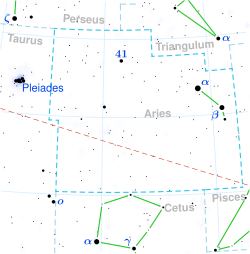Top Qs
Timeline
Chat
Perspective
Epsilon Arietis
Binary star system in the constellation Aries From Wikipedia, the free encyclopedia
Remove ads
Epsilon Arietis is a visual binary[8] star system in the northern constellation of Aries. Its name is a Bayer designation that is Latinized from ε Arietis, and abbreviated Epsilon Ari or ε Ari. This system has a combined apparent visual magnitude of 4.63[2] and can be seen with the naked eye, although the two components are too close together to be resolved without a telescope. With an annual parallax shift of 9.03 mas,[9] the distance to this system can be estimated as 361 light-years (111 parsecs), give or take a 7 light-year margin of error. It is located behind the dark cloud MBM12.[6]
The brighter member of this pair has an apparent magnitude of 5.2.[3] At an angular separation of 1.426″±0.010″ from the brighter component, along a position angle of 209.2°±0.3°,[8] is the magnitude 5.5 companion.[3] Both are A-type main sequence stars with a stellar classification of A2 Vs.[4] (The 's' suffix indicates that the absorption lines in the spectrum are distinctly narrow.) In the 2009 Catalogue of Ap, HgMn and Am stars, the two stars have a classification of A3 Ti,[3] indicating they are Ap stars with an anomalous abundance of titanium. Within the measurement margin of error, their projected rotational velocities are deemed identical at 60 km/s.[4]
Remove ads
Name
This star system, along with δ Ari, ζ Ari, π Ari, and ρ3 Ari, were Al Bīrūnī's Al Buṭain (ألبطين), the dual of Al Baṭn, the Belly.[10] According to the catalogue of stars in the Technical Memorandum 33-507 - A Reduced Star Catalog Containing 537 Named Stars, Al Buṭain were the title for five stars :δ Ari as Botein, π Ari as Al Buṭain I, ρ3 Ari as Al Buṭain II, ε Ari as Al Buṭain III and ζ Ari as Al Buṭain IV[11]
In Chinese astronomy, Epsilon Arietis may be or may be part of Tso Kang (from Cantonese 左更 zogang, Mandarin pronunciation zuǒgēng).[12][13]
Remove ads
References
External links
Wikiwand - on
Seamless Wikipedia browsing. On steroids.
Remove ads

